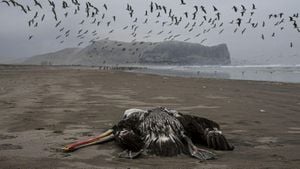The safety situation at Ukraine’s Zaporizhzhia Nuclear Power Plant (ZNPP), under Russian occupation since March 2022, has deteriorated following reports of drone activity near its perimeter. The International Atomic Energy Agency (IAEA) expressed deep concerns about the recent incidents as military operations intensified around the facility.
The IAEA confirmed on August 17, 2023, the drone strike, which reportedly occurred close to the plant's cooling water sprinkler ponds and just meters from the last operational power line supplying electricity. Director General Rafael Mariano Grossi warned of escalating nuclear risks during conflict and called for maximum restraint.
Russian state media reported allegations from the plant's management claiming the Ukrainian military launched the drone attack, which targeted the road outside the plant. Meanwhile, Kyiv has consistently accused Moscow of using the ZNPP as a military base to launch attacks against Ukrainian positions, raising fears of nuclear safety threats.
The IAEA dispatched inspectors to evaluate the impact of the drone strike, confirming no injuries or damage to the plant's equipment but observing significant military activity near the site over recent days. Grossi reiterated the importance of the agency's five principles for nuclear safety, urging all parties to adhere strictly to these guidelines.
This incident follows other alarming signs at Zaporizhzhia, including reports of fires and recent military buildup. On August 12, there was also a fire at the plant’s cooling towers, which caused considerable damage, but no immediate nuclear safety threats were reported.
Grossi highlighted the vulnerability of nuclear facilities within conflict zones, stating, "Nuclear power plants are built to withstand technical failures or natural disasters, not direct military attacks." The IAEA continues to monitor the situation closely, emphasizing the urgent need for de-escalation.
Ukraine has categorically denied Russia's allegations of planning an assault on the Kursk Nuclear Power Plant, calling the claims mere propaganda. Foreign Ministry Spokesperson Heorhii Tykhyi asserted on August 16, “We officially refute these false reports. Ukraine has neither the intention nor the ability to carry out any such actions.”
The Zaporizhzhia Nuclear Power Plant is significant not only for its scale, being the largest nuclear facility in Europe, but also due to its location adjacent to active combat zones. This precarious situation perpetuates fears of potential disasters, impacting both the local population and broader international safety.
With the power plant's safety under constant threat, the international community is left weighing the consequences of continued military operations around this sensitive facility, hoping for diplomatic resolution rather than escalation. Reports from the IAEA and conflicting narratives from both Russia and Ukraine highlight how the conflict continues to evolve, with the stakes getting higher, particularly concerning nuclear safety.



